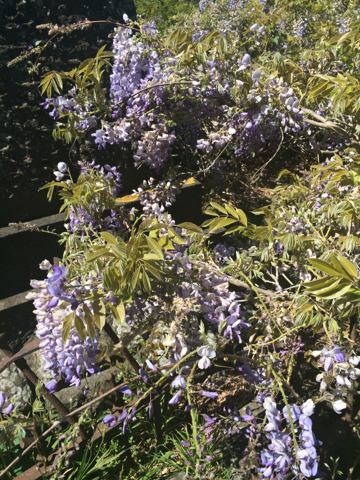Chinese Wisteria
Wisteria sinensisSummary 5
Wisteria sinensis (Chinese wisteria) is a woody, deciduous, perennial climbing vine in the genus Wisteria, native to China in the provinces of Guangxi, Guizhou, Hebei, Henan, Hubei, Shaanxi, and Yunnan. While this plant is a climbing vine, it can be trained into a tree-like shape, usually with a wavy trunk and a flattened top.
Ecological threat in the united states 6
The hard woody vines of Chinese wisteria twine tightly around host tree trunks and branches and cut through the host tree bark, eventually girdling and killing it. On the ground, new vines germinating from seed or sprouting from rootstocks form dense thickets that smother and shade out native vegetation and impede natural plant community development. As girdled trees die, canopy gaps are created which increase the amount of sunlight reaching the forest floor. While this may temporarily favor some native species, it also stimulates vigorous growth and spread of wisteria.
Impacts and control 7
More info for the terms: cover, fire management, hardwood, invasive species, prescribed fire, presence, restoration, vine, vines
Impacts: Information regarding the impacts of wisterias on invaded communities includes evidence that both species displace existing vegetation by strangling or shading out native plants and trees [17,21,30,34,35]. The death of large trees from wisteria establishment results in breaks in closed canopy forest, which favors further growth and spread of wisteria [17]. Once established in an area, wisteria patches can potentially cover several acres; one herbicide experiment in Alabama was conducted in a Chinese wisteria patch that covered 2 to 3 acres (1 ha) [22]. The presence of Chinese wisteria was listed as a problem in the restoration of bottomland hardwood forests in Mississippi [32] and threatens old-growth remnant stands of longleaf pine in the Southeast [40]. Chinese wisteria is also listed as occurring on National Wildlife Refuges in Florida [16].
While both wisteria species are listed as invasive species of concern in a number of states, information as of 2009 suggests that they are less of a perceived threat than other, co-occurring invasive species [23,29,37,44]. For example, in a paper describing woody invaders of eastern forests, Japanese and Chinese wisteria are not considered as much of a threat as other woody vines, including Oriental bittersweet (Celastrus orbiculatus), Japanese honeysuckle (Lonicera japonica), or kudzu (Pueraria montana) [44]. However, that status may change in the future.
Control: In all cases where invasive species are targeted for control, the potential for other invasive species to fill their void must be considered, no matter what method is employed [5]. Information presented in the following sections may not be comprehensive and is not intended to be prescriptive in nature. It is intended to help managers understand the ecology and control of wisterias in the context of fire management. For more detailed information on control of Japanese or Chinese wisteria, consult the references cited here or local extension services.
Fire: For information on the use of prescribed fire to control this species see Fire Management Considerations.
Prevention: No information is available on this topic.
Cultural: No information is available on this topic.
Physical and/or mechanical: One review outlines strategies for cutting climbing or trailing vines of Japanese wisteria. Wisteria can sprout numerous times after cutting, so the treatment must be repeated until root stores are exhausted. If done approximately every 2 weeks from spring until autumn, cutting prevents seed production and strangulation of surrounding vegetation. This type of treatment is appropriate for small populations, as a pre-treatment for large, impenetrable sites, or in areas where herbicides are not appropriate [30].
It is also possible to try to control juvenile or isolated Japanese wisteria plants using a pulaski or similar digging tool to remove the entire plant, including all roots and runners. Any portions of the root system not removed are capable of sprouting. This treatment is appropriate for small initial populations or areas where herbicide use is not feasible [30].
Biological: No information is available on this topic.
Chemical: A range of foliar spray herbicides has been effectively used for wisteria control [22,30], though high rates and repeated applications were needed to produce near-eradication [22] and it was possible to damage non-target species with treatment. Cut-stump application of glyphosate or triclopyr 2 inches (5 cm) above ground level was also found to be effective for Japanese wisteria control, though foliar spray treatments may be needed afterward to compensate for the stimulation of wisteria seedlings after large vine removal [30]. Care must be taken when other invasive species are present; in one herbicide treatment, the reduction in Chinese wisteria cover released the invasive Chinese privet (Ligustrum sinense), which was not impacted by the herbicides [22].
Integrated management: No information is available on this topic.
Sources and Credits
- (c) Du-Sa-Ni-Ma, some rights reserved (CC BY-NC), http://www.flickr.com/photos/dusanima/474491306/
- (c) d_kluza, some rights reserved (CC BY-NC-ND), uploaded by d_kluza
- (c) Steven J. Baskauf, some rights reserved (CC BY), http://bioimages.vanderbilt.edu/baskauf/27104
- (c) The Marmot, some rights reserved (CC BY), https://www.flickr.com/photos/themarmot/434019813/
- Adapted by Kate Wagner from a work by (c) Wikipedia, some rights reserved (CC BY-SA), http://en.wikipedia.org/wiki/Wisteria_sinensis
- (c) Unknown, some rights reserved (CC BY-NC-SA), http://eol.org/data_objects/22948897
- Public Domain, http://eol.org/data_objects/24644032
More Info
- iNat taxon page
- African Plants - a photo guide
- Atlas of Living Australia
- Biodiversity Heritage Library
- BOLD Systems BIN search
- Calflora
- CalPhotos
- eFloras.org
- Flora Digital de Portugal
- Flora of North America (beta)
- Global Biodiversity Information Facility (GBIF)
- Go Botany
- HOSTS - a Database of the World's Lepidopteran Hostplants
- IPNI (with links to POWO, WFO, and BHL)
- Jepson eFlora
- Maryland Biodiversity Project
- NatureServe Explorer 2.0
- NBN Atlas
- New Zealand Plant Conservation Network
- OregonFlora.org
- SEINet Symbiota portals
- Tropicos
- USDA PLANTS database
- VASCAN by Canadensys
- World Flora Online
- 日本のレッドデータ検索システム
- 植物和名−学名インデックス YList








